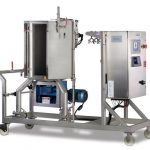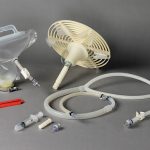The benefits of including single-use/disposable systems in a process are various. One significant improvement has been developed by Alfa Laval with its patented Hynetics single-use mixing system. This system provides the ability to efficiently mix powder/liquid or liquid/liquid solutions as well as maintain suspensions in a single-use environment.
The Hynetics mixing system is designed to meet the strictest cGMP and regulatory requirements within the life science industry. The batch size ranges from 5 to 10,000 l and the modular design ensures low costs, quick delivery and use of standardised spare parts. Single-use systems like the Hynetics technology will significantly reduce the cost and time for designing and building new facilities. It will also eliminate the need for expensive cleaning systems and validation of equipment between batches while minimising the risk of cross-contamination. This will result in substantial savings in up-front capital and ongoing operating costs.
The Alfa Laval mixing systems are fully enclosed. Once configured, the units are highly versatile and can be customised to meet specific performance requirements. Alfa Laval maintains a fully equipped testing facility for demonstrating the effectiveness of the single-use system and for evaluating and tailoring the process and equipment to clients’ individual specifications. Hynetics single-use mixing systems can be used to prepare media, buffer and final formulations, intermediate product solutions and homogeneous suspensions such as for adjuvanted vaccines.
Design features
The heart of the system is a hexagonal holding vessel to provide turbulence at the corners and enhance mixing. An access door is provided in the side wall to allow a disposable bag to be positioned at the bottom. The disposable mixer shaft is connected to a drive that translates rotational output from an electric motor into reciprocating motion. The mixer speed can be varied to achieve mild to aggressive agitation and load cells are available to indicate the solution weight. Temperature is measured externally to the process and can be controlled using an optional heat transfer surface that is integrated in the vessel. Other options include a peristaltic pump, racks to hang disposable filters, automatic inflate and purge valves and lifting devices to assist powder handling. The process is controlled by relay logic with hard-wired interlocks or, optionally, using a PLC or DCS platform.
Every Hynetics mixing system is thoroughly tested and inspected prior to shipment and comes with a documentation package detailed sufficiently to support IQ/OQ. Furthermore, a complete factory acceptance test (FAT) is performed, including an operational sequence check that parallels actual process conditions using single-use liners, tube sets and filters.
Working principle
The mixing technology is exactly the same for all sizes, facilitating the scale-up from lab to pilot to full-scale production. The core component of the mixing technology is the mixing disc itself, which is an integral part of the disposable bag. It is made of plastic, with multiple slots that extend right through the disc. Attached to the disc are plastic flaps, which open as the disc moves up from the bottom of the mixing bag and fluid flows through the slots of the disc. During the downstroke, these flaps close and energy is directed towards the bottom of the vessel and up the walls, producing very effective mixing. All parts of the mixer and the bag are disposable.
The mixing bag contains a powder port on the top, to which a powder feed bag can be attached. Powder is then delivered through this port dust-free. A liquid port is located on top of the mixing bag for connecting equipment such as a WFI source. A spray device, fitted inside the bag, is an integral part of this liquid port. As fluid is added to the mixing bag, it sprays out to wash down any powder either in the headspace or on the bag walls and falls on any powder still floating on the liquid surface. There is also a vent port on top of the mixing bag as well as two ports on the bottom. One is for evacuating the bag while the other is a recirculation port. Sampling or supplementing can thus be accomplished via a recirculation loop if required. The preferred filtration scheme is located downstream of the peristaltic pump, followed by the client’s choice of either a filling system or some other specific use of the content mix.
Interest versus operational use
However, interest in single-use systems within the industry has not always translated into purchases. Lack of economic data has been the primary shortcoming, as market growth for disposables depends on financial justification. Case studies involving real-world data are imperative to the success of these products, as decision-makers require objective information to validate purchases.
In 2005, Alfa Laval conducted a return-on-investment (ROI) analysis for a confidential client to evaluate the feasibility of installing a Hynetics single-use system in its pilot plant facility. The system is to be used for media preparation in a biotech application. The Hynetics system was compared to the alternatives of pre-formulated, sterile, filtered media from an outside vendor or a conventional stainless steel system.
ROI analysis and results
The primary objective of the analysis was to assess the capital and operating cost benefits of preparing 3000 l of media for a non-GMP pilot plant bioreactor while considering three options. These were: Option 1 – Outsource media, Option 2 – Prepare media on site with a single-use mixing system based on Hynetics technology, and Option 3 – Prepare media on site with a traditional stainless steel media prep system. For the purpose of the economic evaluation, the net present value (NPV) of each option was calculated based on a five-year lifecycle for the bioreactor. The capital equipment costs were depreciated using a straight-line method for seven years and the capital facility costs using a straight-line method for 39 years. The operating costs were adjusted annually to account for inflation at a rate of 3 %. An annual tax rate of 35 % and a cost-of-capital rate of 5 % were assumed to discount future cash flows.
The table provides a comparison of the three options for evaluating quantitative results. It includes a breakdown of all capital and operating costs, as well as the NPV, for each of the options. Preparing media on site in lieu of using pre-formulated prod-ucts can result in substantial cost savings over the five-year lifecycle of the 1000 l prototype reactor. Both the Hynetics system (Option 2) and the traditional stainless steel system (Option 3) provide a significant cost advantage, saving of more than 10 million dollars over the five-year period when compared to purchasing pre-formulated media. Option 3 is the most capital-intensive of the three scenarios, with the majority of the cost differential associated with the installation of piping for CIP and SIP.
Option 1 incurs the highest operating costs, with significant expenditure attributed to the purchase of pre-formulated media. The cost of outsourcing the preparation of media is higher than the total operating costs for both options 2 and 3. There is a negligible difference in operating costs between options 2 and 3. This is due to the fact that the cost of the raw media components far outweighs the sum total of all other operating expenses.
While the financial analysis illustrates a minimal difference in both initial capital and yearly operating costs between the Hynetics system and a stainless steel vessel, the Hynetics solution is superior in terms of qualitative advantages. The elimination of SIP and CIP shortens cycle times, simplifies process operation and reduces the potential for operator error. The manual nature of the Hynetics principle eliminates the majority of risks associated with pos-sible mechanical failure. Other advantages include a greater assurance of sterility, easier QA/QC and increased scalability.
Although difficult to quantify, it is also important to examine the less tangible cost savings to understand the full benefit of utilising the Hynetics system. A certain value should be assigned to the reduction in the risk associated with cross-contamination, as alternative choices could result in batch failure and significant financial losses in the event of such an incident. Savings are also achieved due to the reduced proces-sing times and increased processing capacity as well as to the potential acceleration of plant start-up time.
cpp 474
2nd European Congress on Life Science Process Technology – Technopharm
More about Hynetics system
APV – International Association for Pharmaceutical Technology
Share:








